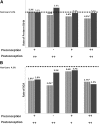Periconceptional multivitamin use and risk of preterm or small-for-gestational-age births in the Danish National Birth Cohort
- PMID: 21795441
- PMCID: PMC3155933
- DOI: 10.3945/ajcn.111.012393
Periconceptional multivitamin use and risk of preterm or small-for-gestational-age births in the Danish National Birth Cohort
Abstract
Background: The intake of periconceptional multivitamins may decrease the risk of preterm births (PTBs) or small-for-gestational-age (SGA) births.
Objective: We related the timing and frequency of periconceptional multivitamin use to SGA births and PTBs and its clinical presentations (ie, preterm labor, premature rupture of membranes, and medical induction).
Design: Women in the Danish National Birth Cohort (n = 35,897) reported the number of weeks of multivitamin use during a 12-wk periconceptional period. Cox regression was used to estimate the relation between any multivitamin use and PTBs (<37 wk) or SGA births (birth weight adjusted for gestational age >2 SDs below the mean on the basis of fetal growth curves). The timing (preconception and postconception) and frequency of use were also analyzed. Regular users (4-6 wk) and partial users (1-3 wk) in each period were compared with nonusers.
Results: The association between periconceptional multivitamin use and PTBs varied according to prepregnancy overweight status (P-interaction = 0.07). Regular preconception and postconception multivitamin use in women with a prepregnancy BMI (in kg/m(2)) <25 was associated with reduced risks of a PTB (HR: 0.84; 95% CI: 0.73, 0.95) and preterm labor (HR: 0.80; 95% CI: 0.69, 0.94). No similar associations were shown for overweight women. The adjusted risk of an SGA birth was reduced in multivitamin users regardless of their prepregnancy BMI (HR: 0.83; 95% CI: 0.73, 0.95), with the strongest association in regular users in the postconception period.
Conclusion: Regular periconceptional multivitamin use was associated with reduced risk of SGA births and PTBs in nonoverweight women.
Figures


Comment in
-
Folic acid supplementation and risk reduction in preterm birth.Am J Clin Nutr. 2011 Dec;94(6):1651-2. doi: 10.3945/ajcn.111.026690. Am J Clin Nutr. 2011. PMID: 22106418 No abstract available.
References
-
- Abrams B, Newman V. Small-for-gestational-age birth: maternal predictors and comparison with risk factors of spontaneous preterm delivery in the same cohort. Am J Obstet Gynecol 1991;164:785–90 - PubMed
-
- David RJ, Collins JW., Jr Differing birth weight among infants of U.S.-born blacks, African-born blacks, and U.S.-born whites. N Engl J Med 1997;337:1209–14 - PubMed
-
- Fox SH, Koepsell TD, Daling JR. Birth weight and smoking during pregnancy–effect modification by maternal age. Am J Epidemiol 1994;139:1008–15 - PubMed
-
- Zeitlin JA, Ancel PY, Saurel-Cubizolles MJ, Papiernik E. Are risk factors the same for small for gestational age versus other preterm births? Am J Obstet Gynecol 2001;185:208–15 - PubMed
Publication types
MeSH terms
Substances
LinkOut - more resources
Full Text Sources
Medical

